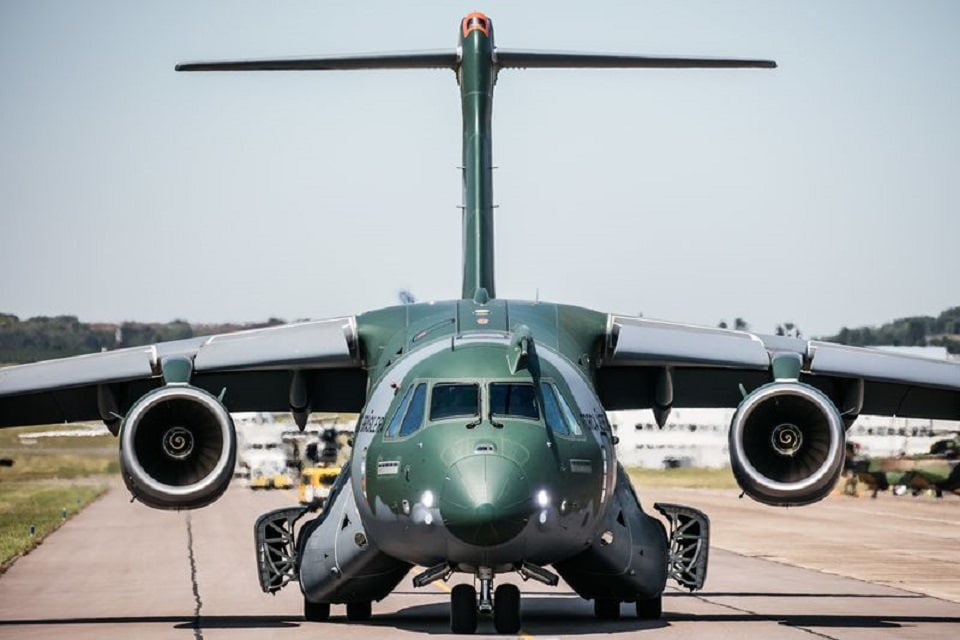Aerospace
Embraer is offering India with the option of producing the C390 military plane locally.

According to the reports, The Embraer has shown interest in submitting a bid for the medium cargo weight aircraft under the Indian Defense tender. The Indian military forces will find this aircraft to be very useful. The C-390 Millennium, a medium-sized, twin-engine, jet-powered military transport aircraft, was flown to India for Aero India 2023 by the Brazilian multinational aerospace manufacturer.
The C-390, which can carry a 26-ton payload of cargo, has been confirmed to be precisely adapted for Indian high-altitude missions by Embraer experts who spoke to HAL. The company is eager to provide the Transporter to the IAF for technical trials in order to demonstrate its capabilities.
The aircraft was designed to operate on semi-prepared or damaged runways as well as in hostile environments, ranging from hot & humid to cold, dry conditions.
Jetline Marvel C390 tour at Aero India
The C-390 has been marketed as a jet-powered alternative to the C-130 Hercules produced by Lockheed Martin. In April 2013, Brazil, Portugal, Hungary, Argentina, Chile, Colombia, and the Czech Republic signed agreements for a total of 60 C-390

Aerospace
When Ratan Tata was denied entry to the airfield at the Aero India show, he waited

During our visit to Aero India 2019, we had the unexpected opportunity to see Ratan Tata at the event, which was a thrilling moment for us. However, there was a surprising hiccup when the security staff didn’t allow him to enter due to a lack of a security pass.
Despite this, he remained calm and patiently waited for about 20 minutes until a member of the Tata team brought him the required pass, after which he calmly proceeded inside. It was a humbling sight, showcasing his composed demeanor even in such situations.
Ratan Tata ji is not only a renowned industrialist but also a trained pilot, holding a pilot’s license. In 2007, he became the first Indian civilian to fly the F-16 Falcon during the Aero India show in Bangalore—a proud moment for the nation.
His passion for aviation extended beyond flying, as he played a key role in shaping India’s aerospace industry. Under his leadership, Tata ventured into manufacturing and maintaining aerospace components while upholding its legacy of quality. Notably, Tata’s collaboration with Airbus to develop and manufacture the C295 aircraft is a testament to its growing influence in the sector.
-

 Aviation2 months ago
Aviation2 months agoMicrosoft Flight Simulator Raises $3 Million to Bring Back the An-225 Mriya
-

 Airlines2 months ago
Airlines2 months agoQatar Citizens Can Travel to the United States Without a Visa
-

 Aviation2 months ago
Aviation2 months agoQatar Airways bans these new Electronic Devices on plane
-

 Airlines2 months ago
Airlines2 months agoJapan Airlines Rolls Out Free Domestic Flights to International Passengers
-

 Defence2 months ago
Defence2 months agoWhich Country Has the Largest Fleet of Fighter Aircraft?
-

 Airport2 months ago
Airport2 months agoWestern Sydney Airport Welcomes Its First Plane After 6 Years of construction
-

 Airlines4 days ago
Airlines4 days agoDAMAC Air: Dubai’s New Luxury Airline Offers Free Flights for Registration
-

 Aviation2 months ago
Aviation2 months agoDid you know ? Once Boeing 747 carried 1088 passenger in 1991








